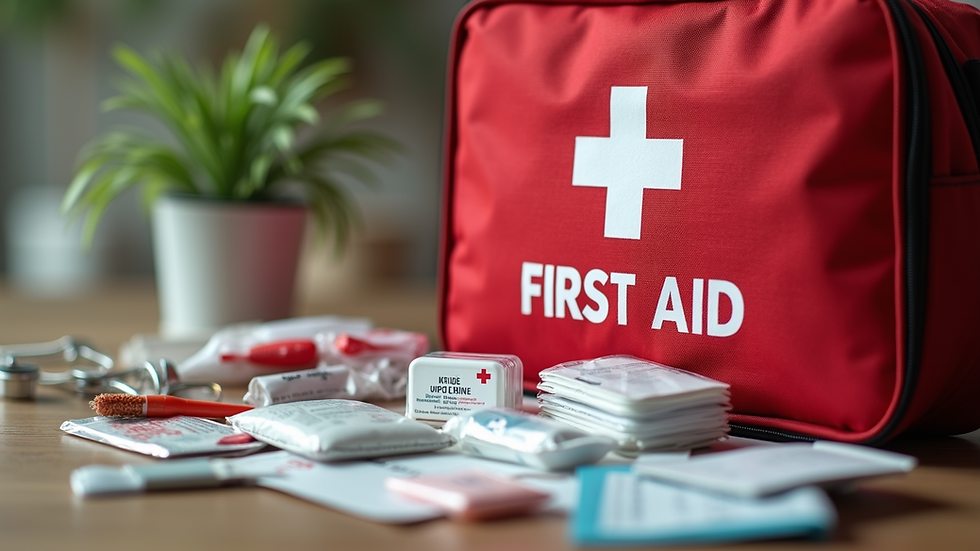From Farm to Fork: Ensuring Food Safety for a Healthy World
- Aryeh Goldberg

- Jun 5, 2023
- 4 min read
Updated: Jun 8, 2023
By: Alyson Essex
In today's world, where food is readily available and consumed on a daily basis, ensuring food safety is vital. The Qualsafe Level 2 Food Safety RQF e-Learning Course offers a comprehensive learning experience to individuals working with food, providing them with the knowledge and skills to maintain the highest food safety standards.
I was asked to review this course by Plan for Safety. This course is aimed at people working with food but the reality is everyone can benefit. I don’t work with food but I do cook every day and I found the information and the course delivery excellent and thoroughly enjoyed the learning experience. I chose the e-learning option as I could complete the course at my own pace. Once completed a regulated qualification is awarded by attending an invigilated regulated assessment (a must have for those working with food). Even though I opted not to attend the assessment, I still received a certificate to confirm I had completed the course.

The course offers fantastic value. To complete the e-learning course costs just £18 per person, which is worth every penny. For anyone working with food it’s a ‘no-brainer’ and you simply can’t afford not to have completed it. For those like me who enjoy cooking but don’t work with food, it also represents fantastic value and is worth every penny. I cook with even more confidence now and have definitely learnt a thing or two.
The course is split into six modules and I found it easy to understand and it was delivered in a simplified way. Videos and images are used to illustrate information which makes it much easier to absorb. At the end of each module there is a summary and short test, to reinforce all the key points of the module. For anyone working, or planning to work, in a food retail, catering or manufacturing environment such as restaurants, cafes, supermarkets or premises with hot and chilled food display counters, this course is a MUST. It covers everything you need to know about operating a food business safely!
Module one covers ‘Understanding Food Contamination and Allergies’. I was particularly surprised to learn that contamination can occur at any stage of the food chain, from production to consumption. This module comprehensively covers the many types of contamination, including bacterial contamination, allergenic contamination and toxins and emphasises the importance of correctly displaying allergen information and identifies major allergens that must be considered. On 1st October 2021 Natasha’s law came into effect, after Natasha Ednan-Laperouse who, at the age of 15, passed away due to a severe allergic reaction. Natasha had a sesame allergy and was not made aware that sesame seeds had been baked into the bread of a sandwich she had purchased. The module also provides insight into the causes and risks of food poisoning and airborne diseases.
The second module addresses ‘Compliance with Food Safety Legislation’ To operate within the law, food businesses MUST comply with relevant food safety legislation. This module provides an overview of the main food safety regulations and demonstrates how to implement systems to ensure compliance. It highlights the significance of maintaining up-to-date records, such as personal hygiene, deliveries, pest control, systems to minimise risk, training, and cleaning. By demonstrating due diligence and keeping proper records businesses can defend themselves should they face legal action.
Module three emphasises the importance of personal hygiene, particularly handwashing, to prevent the spread of harmful bacteria. It covers the steps necessary to maintain high hygiene levels in the workplace, along with proper refuse and waste disposal techniques. By implementing these practices, individuals contribute to a safe and clean food environment.
Module four covers ‘Ensuring Safe Food Premises and Equipment’. Did you know the design and layout of food premises and equipment play a crucial role in food safety and food contamination risks? It provides insights into preventing pest infestations, minimising cross-contamination and checking deliveries for signs of pests or contamination.
Maintaining proper temperature control is vital to prevent the growth of harmful bacteria and ensure food safety.
Module five covers the importance of temperature control during storage, preparation, and cooking. It provides insight into the danger zone and how to handle food appropriately to keep it safe. This module also covers topics like cooking and reheating food safely, holding warm food, and proper use of freezers, refrigerators, and display units.
Module six covers ‘Effective Delivery Inspection’. It equips learners with the skills to inspect deliveries effectively, ensuring that only safe and high-quality ingredients and products enter the food premises. It covers the criteria for accepting or rejecting a delivery and how to store food safely.
Conclusion:
The Qualsafe Level 2 Food Safety Course offers a comprehensive learning experience, empowering individuals to prioritise food safety in their work environment. By understanding the risks associated with food contamination, complying with food safety legislation, maintaining hygiene and cleanliness, ensuring safe premises and equipment, practicing temperature control, and conducting effective delivery inspections, we can all contribute to a safer food industry.
Prioritising food safety is not just a legal obligation but a responsibility that ensures the well-being of consumers and protects against foodborne illnesses. Regardless of whether you work with food professionally or simply want to enhance your knowledge like I did, this course provides valuable insights to benefit everyone.





Comments